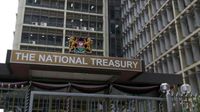
Guests during a pension trustees and administrators meeting in Nairobi on September 16, 2021. PHOTO | DIANA NGILA | NMG
Pension funds that eschew risk are reaping the benefits of their conservative approach to investments, outperforming their more aggressive peers whose returns are being dented by bigger exposure to underperforming equities and offshore assets.
Conservative schemes, which on average allocate over 80 percent of their assets under management to risk-free, stable yielding government securities, recorded a return of 2.9 percent in the year to June 2022, industry analysis done by fund administrator Zamara shows.
Schemes with a moderate approach to investment, which seeks to strike a balance between risky and safe investments, had a return of negative 0.3 percent in the period. These types of schemes (215) are the majority among the 436 polled by Zamara.
Meanwhile, those that aggressively seek returns by going overweight in offshore, listed shares, and property investments returned a negative 2.3 percent. These schemes put in just 39.2 percent of assets under management into fixed income instruments, while allocating equities, property, and offshore investments 21.6 percent, 21.5 percent, and 17.7 percent respectively.
The risk-averse schemes on the other hand allocated equities 13.2 percent, property three percent, and offshore assets 0.4 percent while putting the remaining 83.4 percent in fixed income. Overall, the sector made a 0.5 percent return in the one-year period.
“Conservative schemes posted the highest median returns over all the periods (quarter/annual/three/five-year) aided by a higher allocation towards fixed income that performed strongly over these periods,” said Zamara.
“Aggressive schemes had the lowest median return over all the periods due to lower performance from the quoted equities asset class.”
In a year when equities perform well—such as 2019—the aggressive schemes book higher returns for members.
Stocks in the year to June 2022 were, however, firmly in the red, courtesy of the foreign investor capital flight from the frontier and emerging markets such as the Nairobi Securities Exchange (NSE) to the West where interest rates have risen significantly this year.
In that period, the bourse shed Sh784 billion in investor wealth, while the benchmark NSE 20 Share Index retreated by 16.3 percent in the period to touch a 19-year low of 1612 points.
Offshore investments in the period were also hurt by the global equities downturn, which also coincided with a strengthening of the dollar against almost all other currencies.
While the pension scheme asset allocation towards offshore investments generally remains much lower compared to bonds, equities, property, and guaranteed funds, it has been increasingly seen as an attractive alternative in the chase for higher returns, alongside other emerging options such as private equity and Real Estate Investment Trusts (Reits).
Latest Retirement Benefits Authority (RBA) data shows that by the end of last year, pension funds allocated Sh19.4 billion towards offshore investments, up from Sh11.4 billion in December 2020 and Sh6.32 billion in December 2019.
Total industry assets stood at Sh1.547 trillion at the end of 2021.
cmwaniki@ke.nationmedia.com



No comments:
Post a Comment